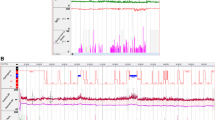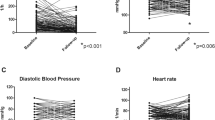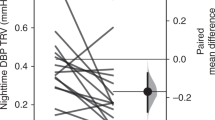Abstract
Obstructive sleep apnea (OSA), is a common clinical condition affecting at least 2–4% of the adult population. Hypertension is found in about half of all OSA patients, and about one-third of all patients with essential hypertension have OSA. There is growing evidence that successful treatment of OSA can reduce systemic blood pressure (BP). Body position appears to have an important influence on the incidence and severity of these sleep-related breathing disturbances. We have investigated the effect of avoiding the supine position during sleep for a 1 month period on systemic BP in 13 OSA patients (six hypertensives and seven normotensives) who by polysomnography (PSG) were found to have their sleep-related breathing disturbances mainly in the supine position. BP monitoring was performed by 24-h ambulatory BP measurements before and after a 1 month intervention period. We used a simple, inexpensive method for avoiding the supine posture during sleep, namely the tennis ball technique. Of the 13 patients, all had a reduction in 24-h mean BP (MBP). The mean 24-h systolic/diastolic (SBP/DBP) fell by 6.4/2.9 mm Hg, the mean awake SBP/DBP fell by 6.6/3.3 mm Hg and the mean sleeping SBP/DBP fell by 6.5/2.7 mm Hg, respectively. All these reductions were significant (at least P < 0.05) except for the sleeping dbp. the magnitude of the fall in sbp was significantly greater in the hypertensive than in the normotensive group for the 24 h period and for the awake hours. in addition, a significant reduction in bp variability and load were found. since the majority of osa patients have supine-related breathing abnormalities, and since about a third of all hypertensive patients have osa, avoiding the supine position during sleep, if confirmed by future studies, could become a new non-pharmacological form of treatment for many hypertensive patients.
This is a preview of subscription content, access via your institution
Access options
Subscribe to this journal
Receive 12 digital issues and online access to articles
$119.00 per year
only $9.92 per issue
Buy this article
- Purchase on Springer Link
- Instant access to full article PDF
Prices may be subject to local taxes which are calculated during checkout
Similar content being viewed by others
Author information
Authors and Affiliations
Rights and permissions
About this article
Cite this article
Berger, M., Oksenberg, A., Silverberg, D. et al. Avoiding the supine position during sleep lowers 24 h blood pressure in obstructive sleep apnea (OSA) patients. J Hum Hypertens 11, 657–664 (1997). https://doi.org/10.1038/sj.jhh.1000510
Received:
Revised:
Accepted:
Issue Date:
DOI: https://doi.org/10.1038/sj.jhh.1000510
Keywords
This article is cited by
-
The undervalued potential of positional therapy in position-dependent snoring and obstructive sleep apnea—a review of the literature
Sleep and Breathing (2013)
-
The sleep position trainer: a new treatment for positional obstructive sleep apnoea
Sleep and Breathing (2013)
-
Non-positive airway pressure therapy for obstructive sleep apnea
Current Respiratory Care Reports (2012)
-
Stellenwert der Nicht-nCPAP-Verfahren in der Therapie des obstruktiven Schlafapnoe-Syndroms
Somnologie - Schlafforschung und Schlafmedizin (2006)
-
Are sleep-related breathing disorders important contributing factors to the production of essential hypertension?
Current Hypertension Reports (2001)



